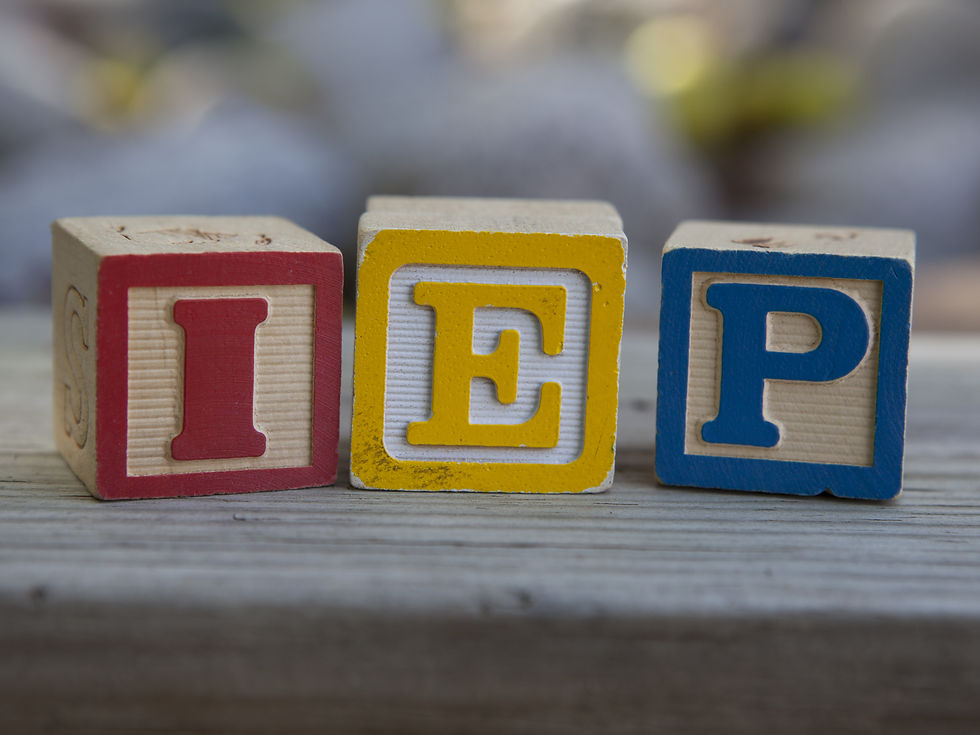IEP Basics
- Charne' Tunson

- Mar 21, 2019
- 3 min read
The basic IEP is made up of seven main components that support one another:
1. Present Levels of Performance (PLOP)
This should define where your child currently is in various areas. Also assessment results would be found in this section.

2. Measurable Goals These should be based on the student's present levels and should be decided by the TEAM- not one individual. Keep them simple and attainable, and remember these goals are just for one year. They will be monitored every quarter and updated at each annual meeting. Rule of thumb is no more than 2 -3 goals. 3. Direct Support Services These services are directly provided by licensed professional in various fields to help achieve the goals that were decided upon by the team. Services can include: speech and language, physical therapy, occupational therapy, behavior aide, counseling and others. The teams decides the frequency of the services and if there are questions or concerns about a particular area, the parent may request an assessment in that area. Make sure to indicate if the service will be provided individually, in a group, or via consultation- we will talk more about this in another post. 4. Supplemental Aids and Services These can be devices and training that will help support the work that the DIS provider is doing, or to meet a goal outlined in the IEP. One of the most common aids are Assistive Technology (AT) primarily for students who are non verbal or have difficulty communicating with others. In this case a device, ipad for example, with relevant software would be provided to the student. Then an AT provider would come in and work with the child as well as the teacher, so that he/she would be able to continue use of the device in the absence of the AT DIS provider. 5. Accommodations / Modifications This is an entire series by itself but the just of it is they are personalized to meet the unique needs of the child. The basic difference is: Accommodations are tools/supports to help the student access the curriculum. For example if a student has attention challenges, when it comes time to take an exam, he/she may have an accommodation that allows them to take the test in a smaller environment such as a Learning Center. Students with Section 504 Plans may have similar accommodations. Modifications are changes to the curriculum that allow the student to master the object according to his/her goals. For example, if a History class has an assignment that requires them to make an oral presentation, a non-verbal student would have a modified assignment; possibly create a visual presentation via collage or poster. Students with Section 504 Plans do not receive modifications. 6. Least Restrictive Environment (LRE) This is a very crucial piece to the IEP because it identifies the best educational setting that will help the student achieve Goals and improve Present Levels. Examples of LRE would be: General Education Classroom (GE), Resource Support (RSP), Self-Contained Classroom (SDC, CBI) Non-Public School (NPS), Residential Transition Center (RTC) or any other physical environment. Being in a General Education setting is considered the "Least Restrictive" while attending a RTC is very restrictive. 7. Transition Plan (14 and up) What's next? Once a student turns 14, it is time to think about life after high school. Best practice would be for the Transition Coordinator to attend the IEP meeting, however meeting with the student annually is most common. This section of the IEP is often rushed through or passed over, but it is just as important as the other sections. There may be additional sections depending upon the format that your school or district uses; however, if your document is missing any of the sections 1-6, HOUSTON we have a problem.

Comments